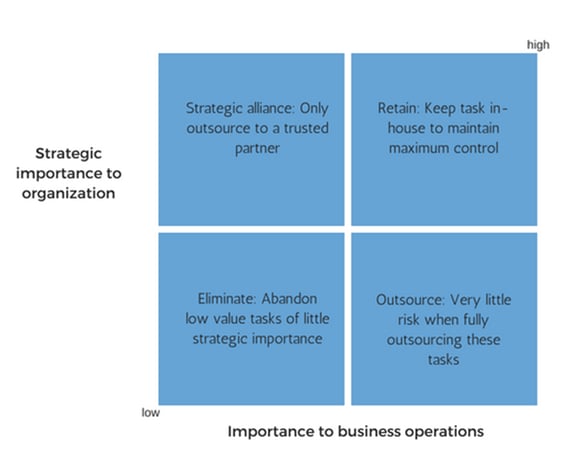Staff shortages in intensive care or catering? Simply send an email to a staff provider and find three additional nurses or service staff members on your doorstep the next day. You don't know anything about SEO? Surely you can find an expert who can teach it to your team in a workshop next week.
Companies who use third parties to source their staff at least in part can be much more spontaneous in their planning and can benefit from know-how that is lacking within their own organisation. At a first glance, this seems like a dream come true.
However, nothing is perfect and staff outsourcing certainly has its downsides too. Not every task can be managed by an outsider and often, outsourcing turns out to be quite pricey. In this article, we would like to outline when it is a good idea to hire a third party to do a certain job and when it is better to invest in in-house resources.
Outsourcing and Insourcing of Human Resources − a Definition
Outsourcing is a business practice which sees companies hire other firms or individuals to execute certain tasks, manage operations or take over services which are usually provided by in-house stuff, or were provided by them previously.
When we talk about outsourcing staff, outsourced services refer to anything which is provided directly by people. This stands in contrast to outsourcing of processing power or mechanical production steps, for example.
Some instances of outsourcing are:
- Staff providers/staffing agencies who provide temporary staff on short notice
- Self-employed workers who can be hired on an ad-hoc basis
- Agencies who provide external services to you
- Consulting firms who offer consultants for certain projects
- Etc.
Insourcing is the exact opposite. Instead of giving tasks to external workers, human resources from inside the company are used. Usually, when a company decides to insource certain areas of business, employees will have to be trained or hired.
A good example of insourcing is using a pool of float nurses in healthcare – which you can read about here. The use of temporary staff pools is also widespread in catering and hospitality industries.
Advantages and Disadvantages of Staff Insourcing vs. Outsourcing
Outsourcing is not always well-regarded, since working models such as contracting can lead to workers being exploited. A current example which has made headlines is Wework. Due to financial difficulties, the company decided last year that it would no longer employ its cleaning staff. Instead, their contracts were changed, with the result of them officially working for a third-party employer. This allowed Wework to use the cleaners more flexibly. Those who did not agree to a change in contract were made redundant, while a variety of employee benefits were removed under the new contracts.
However, even if this example implies that outsourcing can be abused, it should not be equivalent to lowering payroll costs. Usually, external workers are even more expensive than internal ones, as long as no wage dumping takes place. Nevertheless, outsourcing can save certain costs, for example in the following areas:
- Training cost

- Staff opportunity costs (when not very profitable tasks which have been executed by in-house staff up to now are given to external service providers instead)
- Equipment and working materials (such as staff uniforms, laptop, technological tools…)
- Ancillary wage costs (holiday, sick leave, bonus…)
Aside from saving on cost, outsourcing workers also has additional benefits. Next to recruiting, it makes the entire administrative expenditure around payroll accounting and staff planning unnecessary.
Insourcing, on the other hand, lets companies take back control. While this is tied to higher expenditure, in-house staff are usually cheaper, their knowledge remains in the company for longer and they can usually deliver a higher quality of service.
However, insourcing only works when internal employees with an adequate skill level are available. This is a basic requirement. Where there are no suitable human ressources, employees will have to be trained, upskilled or hired.
And this is not always profitable. In the following section we will look at the outsourcing decision matrix. To recap, here are the advantages of insourcing vs. outsourcing at a glance:
|
Insourcing |
Outsourcing |
|
|
Advantages |
|
|
|
Disadvantages |
|
|
The Outsourcing Decision Matrix – When Is Insourcing Suitable, When Is Outsourcing Preferable?
You are not the first company to ask the question: outsourcing, yes or no? The outsourcing decision matrix devised by Dornier in 1999 offers a clear basis for an answer. For every area of business which could possibly be outsourced, two metrics need to be determined:
- Strategic importance to the company
- Importance to business operations

What is striking: according to Dornier, there are two completely different cases in which outsourcing would be suitable. One applies when outsourcing contributes strongly to business operations. The other applies in the exact opposite scenario.
An illustrative example for this matrix
Let us imagine a hotel with seminar rooms.
High strategic importance and low contribution to business operations:
When it comes to the hotel's instagram account - should they decide to give social media a whirl - it is unnecessary to establish an entire marketing department and hire experts. Instead, a third party, such as a social media agency could be contracted. The agency could collaborate with the hotel for a prolonged period of time and keep in close contact when it comes to decision-making.
High strategic importance and high contribution to business operations:
Planning the hotel's New Year's dinner menu and accompanying wines as well as a ball, including a band, should most certainly be taken on by in-house teams. Internal staff know the hotel style, identify with the hotel's values and know exactly what guests might expect from a New Year's ball in the venue. To ensure that the party synergises all these factors, its planning is a task that should not be given to an outsider.
Low strategic importance and high contribution to business operations:
This encompasses all tasks necessary to keep the hotel business running. For example, during the New Year's party, it is likely that additional bartenders are needed, and further staff will be needed to give the venue a thorough tidying and clean-up in the morning. The necessary personnel could be hired from a staff provider.
Low strategic importance and low contribution to business operations:
Hopefully, this won't apply to anything. As an example, let's say the hotel's accounting department is asked to create graphics which reflect the occupancy rate for its seminar rooms. However, in the end, hotel management do not base their decisions on these charts, and they are not useful to anyone else.
And Finally, a Look at the Cost of Insourcing vs. Outsourcing
What the matrix does not make entirely clear: even in cases where outsourcing makes strategic sense, it can still be exponentially expensive and this alone might mean that it is not worth it. Even if room cleaning, which is of low strategic importance, were best outsourced, this would not mean that all jobs should be given exclusively to personnel employed by a third party. After all, this would accrue significant costs in the long run.
So then, what does it take to avoid the cost of outsourcing and rely on internal resources? We have compiled a short checklist:
- Minimum number of regular working hours (e.g. for room service)
- Technology and staff uniforms
- Capacity to recruit in-house staff
And those who rely widely on internal human resources can still benefit from using external help during busy periods or when faced with unusual challenges. On the other hand, those who primarily count on third-party staff employed by staffing agencies, et al. also need in-house staff to take on responsibility and be in charge.









